
by Kosher Casual Team | Nov 12, 2024 | Christmas, Gifts, Hannukah, Holiday Gift Ideas, Holiday Shopping, Holidays, Modest, modest clothing, Modest Fashion
Starting to stress about what to get for the modest women in your life? Look no farther than our guide to holiday gifts for her. Choosing the best holiday gift for the modest woman involves selecting items that fit her style while respecting her preference for modesty. Here, you’ll find 10 great holiday gift ideas for just about anyone on your list!
- Maxi Dress: Select a maxi dress with a modest neckline, long sleeves, and a suitable length. Look for elegant fabrics and classic colors.
- Long Cardigan or Duster: A long cardigan or duster in a neutral shade can be a versatile layering piece. It complements a range of outfits while providing coverage and warmth.

- A-Line Skirt: Choose an A-line skirt that covers the knee for a modest and timeless look. Opt for fabrics and colors that suits her style.
- Jumpsuit: Look for a jumpsuit with a modest tailored cut, such as a higher neckline and longer pants. Jumpsuits can be both fashionable and practical.
- Flowy Blouse or Tunic: Choose a flowy blouse or tunic with a crew neckline and three quarter sleeves. Neutral colors or subtle patterns can enhance its versatility.
- Modest Swimwear: Consider a swimsuit, such as a swim dress or a swim skirt with attached shorts or leggings. Look for simple designs in her preferred colors.
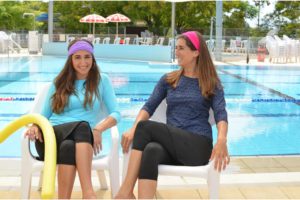
- Classic Turtleneck: A classic turtleneck in a comfortable knit is a versatile and cozy choice for colder seasons. It can be paired with skirts or trousers.
- Activewear: If she loves to exercise look for modest activewear with stretch fabrics. This could include long-sleeve tops, loose-fitting pants, and a sports head covering.
- Loungewear Set: Everyone loves comfy stylish loungewear! A pajama set with long sleeves and a fluffy warm robe can be great for relaxing at home.
- Elegant Jacket or Cardigan: A sophisticated cardigan or jacket in a lush fabric or faux leather can be a chic way to add warmth and interest to her outfits.
When selecting clothing, pay attention to her size, preferred colors, and style preferences. By choosing classic, timeless pieces you can ensure the gift will be both thoughtful and practical for her modest wardrobe. What is the best holiday clothing gift you ever received?

by Kosher Casual Team | Oct 14, 2024 | Basic Tops, Color, Fashion Must-Haves, Layering Tops, Modest Business Casual, modest clothing, Neutrals, Uncategorized
Simplify Your Life with a Capsule Closet!
Do you agonize in the morning what to wear for that day? One simple solution might be a capsule closet, also known as a capsule wardrobe! This is a select collection of clothing items that are versatile, timeless, and well-coordinated as well modest! The idea is simple, your wardrobe has a curated selection of essential pieces that can be mixed and matched to create a variety of outfits. The goal is to maximize versatility, alleviate stress, minimize clutter, and promote a more intentional approach to dressing.
The basic capsule closet usually begins with essential clothing items in neutral colors. Neutrals typically include colors like black, white, gray, beige, navy and muted tones. Additionally, neutral colors are known for their ability to adapt well to different seasons and occasions.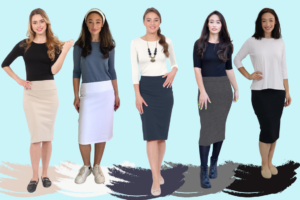
Black: Timeless and versatile, black can be dressed up or down for a variety of occasions. A basic modest black pencil skirt or the “Little Black Dress” are an essential for any capsule wardrobe
White: Clean and crisp, white goes with everything and adds a fresh touch to your outfits. White Layering tops and T-shirts are indispensable for casual outfits and the workplace dress code.
Gray: A neutral color that complements both dark and light tones, often called the “new” black. Heather Greys in deep or pale shades in tunics and skirts are a great alternative to plain grey.
Navy Blue: A classic alternative to black, navy is sophisticated and pairs well with many colors. Skirts or pants in navy or denim are timeless items that ensures longevity and remain relevant season after season.
Beige: A warm neutral that works well for all seasons and complements other colors. Often vilified as boring beige, beige can vary from almond to taupe to walnut and is a staple in any capsule closet. Cardigans, layering pieces and skirts in beige are a great option to white and can be used to create a range of outfits
To add personality and flair to your outfits, you can incorporate accessories in bold and vibrant colors. Here are some bright colored accessories to consider for a capsule closet: scarves, statement jewelry, handbags, belts and shoes. These will add lively pops of color with and encourages you to identify and refine your personal style. Mixing and matching neutrals with bold saturated colors helps define your wardrobe, avoiding unnecessary clutter and focusing on items you love that make you feel confident.
A capsule closet offers several other benefits that contribute to an efficient and sensible approach to personal style. Some key advantages are time-saving, reduced decision fatigue, space saving, a focus on your personal fashion taste, and an appreciation for favorite clothing items. With a curated selection of versatile pieces, getting dressed becomes quicker and easier. You spend less time pondering what to wear, allowing for a smooth morning routine.
What would you include in your capsule wardrobe?
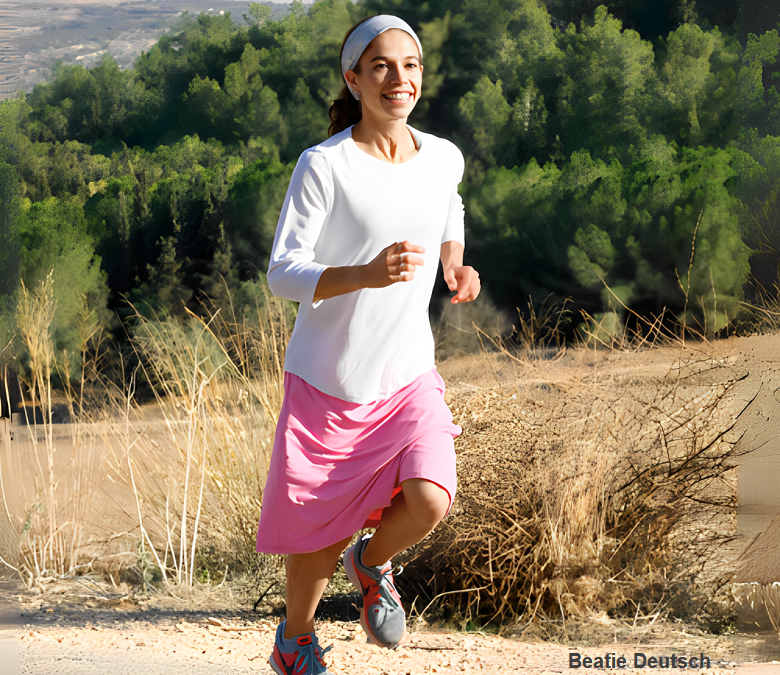
by Kosher Casual Team | Sep 22, 2024 | modest clothing, Religious Modesty standards, Running Skirts, Sports Skirt, workout clothing
Modest Skirt Wearers Can Run Fast!!!
Can I run in a skirt? Absolutely, you can run in a skirt! Many people find it comfortable and stylish. Just make sure it’s a design that allows for movement, like a skort or a running skirt with built-in shorts. It’s all about what makes you feel good while you run! Modest running skirts offer several advantages for those who prefer a more covered style while staying active. Those who prioritize modesty for personal, cultural and religious reasons can still fully enjoy exercise, outdoor recreation or leisure activities.
Several famous female runners have worn skirts during races, either for comfort, style, or sponsorship reasons. Some of them include:
Deena Kastor, Shalane Flanagan and Joan Benoit Samuelson long distance runners and Olympic medalists- have all trained and worn running skirts in races. Beatie Deutsch is an American-Israeli marathon runner who lives in Israel. An Orthodox Jewish mother of five, she only wears sport skirts with leggings or shorts. She has competed in marathons all over Israel and in Berlin, Germany, Tokyo, Japan, Seville, Spain and Cape Town, South Africa often winning first or second place!
How to Select Great Running Skirts
Skirt Design
Look for skirts specifically designed for athletic activities and cuts that allow for a full range of motion.
Choose a skirt length that doesn’t impede your stride, knee-length or slightly above can be ideal. Ensure the fit is not too tight around the hips and thighs to allow for easy movement. Select a length that you find comfortable and that provides adequate coverage for your activity. Find a style that’s versatile! A skirt suitable for running and can be worn during the day with a t-shirt as well as by night with a blouse.
Fabrics
Many sport skirts now are made with moisture-wicking fabric – keeping you dry and comfortable by drawing sweat away from the skin. Some have mesh panels or vents that enhance airflow and prevents chafing.
Four-way stretch fabric offers maximum stretch and durability and will withstand the rigors of training and racing. Another great feature is fabrics that offer UVF protection from the sun. Fabrics should be lightweight and but also opaque (not see through), there are also heavier weight fabrics for fall and winter.
Features
Pockets, who doesn’t love pockets! Who wants to carry a purse? Deep pockets with zippers that have enough room for a cell phone or keys are essential. Another great feature in sport skirts are adjustable waistbands either stretch elastic waistbands or drawstring.
Sport/Swim Skirts should be made for with double stitched seams and hems to be resilient on concrete, hard ground and a range of activities and travel. For early morning or evening runs clothing with reflective elements for safety and visibility is essential. Finally for marathon runners, test your skirt with a shorter run or jog to ensure it’s comfortable and doesn’t cause any issues before running.
Yes, modest skirt wearers can run fast, but there are some aspects to consider to ensure comfort and safety. Many brands offer a variety of styles and fits to cater to different preferences and needs.
What do you want in a running skirt?

by Kosher Casual Team | Sep 18, 2024 | Dress Code, Dress Code, Girls Knee Length Skirts
Are School Dress Codes Modest?
School dress codes vary widely depending on the institution and its location, so the level of modesty can differ significantly. Dress codes are designed to maintain a sense of decorum and reduce distractions in the learning environment. Common religious school guidelines often include:
- Jewish schools might have guidelines that align with tzniut, which typically includes long skirts, sleeves covering the elbows, and avoiding see through blouses or shirts.
- Christian schools might require skirts or dresses for girls, often knee-length or longer, and may prohibit certain types of clothing like sleeveless tops, tight-fitting clothes, or anything deemed too revealing.
- Muslim schools might require hijab for girls, along with loose-fitting clothing that covers the arms and legs.
- Sometimes mandating specific types of clothing, like uniforms, which can inherently be more modest.
- Some dress codes aim for practicality and safety rather than modesty, like requiring closed-toe shoes or banning certain types of jewelry.
While these dress codes are designed to meet the standards of modesty within the school’s religious framework, opinions on what is considered “modest enough” can still vary. Some might find these dress codes perfectly aligned with their values, while others might feel they are either too strict or not strict enough, depending on their personal or community standards.
- Prohibiting clothing that reveals too much skin, such as crop tops, short shorts, and low-cut tops.
- Requiring skirts and shorts to be a certain length, usually no shorter than mid-thigh.
- Banning clothing with offensive or inappropriate graphics or language.
- Prohibited items: Some schools ban clothing with offensive language, images, or references to drugs, alcohol, or violence.
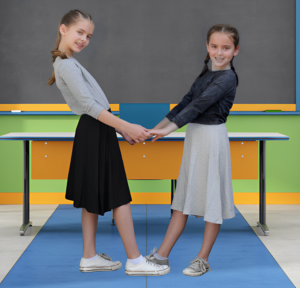
Secular School dress codes in the USA vary widely by district, school, and sometimes even by grade. While there is no standard dress code that applies to all schools, many do have policies intended to promote a level of appropriateness in the school environment. These often include parameters such as:
- No revealing clothing: This can include prohibitions on items like crop tops, short shorts, low-cut tops, and skirts or dresses that are too short (often defined as needing to be fingertip length or longer).
- No visible underwear: Students are usually required to ensure that their underwear is not visible, which means sagging pants or very low-rise jeans may be prohibited.
- Appropriate coverage: Shirts typically need to cover the midriff, and tank tops often need to have straps of a certain width (e.g., no spaghetti straps).
Challenges and Controversies
- Student Expression: Some argue that strict dress codes limit students’ ability to express their individuality.
- Fashion Trends: Fashion trends can influence how students wear their uniforms, sometimes leading to modifications that result in shorter skirts.
- Gender Disparity: Many dress codes are criticized for being more restrictive toward female students. Rules often focus on covering shoulders, legs, and cleavage, while similar restrictions aren’t always applied to male students.
School dress codes generally aim to be modest, but whether they succeed depends on cultural norms, personal beliefs and values. There is an evolving debate about what should be considered modest and how strictly school dress codes should be implemented. Using these guidelines, schools and families can create a dress code that is fair, respectful, and accommodating and strike a healthy balance between fashion and modesty.

by Kosher Casual Team | Sep 18, 2024 | cropped tops, Layering shirts, Layering Tops, modest clothing, Modest Clothing Accessories, Modest Fashion, tank top, Uncategorized
Practical and Creative Modesty Solutions!
Finding creative solutions for modesty can be a bit of a challenge. These key items extend the usability of your wardrobe across different seasons and occasions. Wearing modest clothing can help women feel more comfortable, confident and secure.
NECK
- Mock Neck and Turtlenecks: These tops provide full coverage and can be paired with various outfits.
- High-Neck Blouses: Elegant blouses with high necklines can be both stylish and modest.
- Dickies or detachable shirtfront or a small fabric insert worn to fill in the neckline. A dickey is a way to add versatility to a look, without adding bulk.
- Statement Necklaces: Layered necklaces can cover the collar bone a while adding a stylish touch.
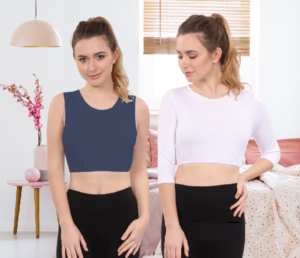
CLEAVAGE
- Mock Tee-shirt collars or Sleeveless Crop Tops. Mock collars and sleeveless crops can give a polished and professional look without being too formal. They provide a layering without bulk.
- Camisoles or Tank Tops: Wear a camisole or tank top underneath your low-cut top. Choose opaque fabrics and higher necklines for fuller coverage.
- Scarves: Lightweight scarves can be draped or tied around the neck to cover the cleavage. Scarves not only cover cleavage, there a great way to add a pop of color and a bit of drama.
ARMS
- Three Quarter sleeve Layering Cropped Tops: Layering a cropped top over a longer top can provide coverage while adding a trendy element to the outfit.
- Detachable Sleeves: Sleeves that can be attached to sleeveless tops or dresses as needed.
- Boleros or Shrugs: Short jackets that cover the arms and can be worn over sleeveless dresses and tops. Covering the arms offers protection from the sun and can add depth and interest to an outfit.
TUMMY
- Bodysuits: A bodysuit with a modest neckline can provide full tummy coverage under skirts pants or sleeveless dresses. Bodysuits don’t “ride up” and provide a smooth or seamless finish.
- Peeking Underneath: Let a tube top or hippie peek out from underneath a cropped sweater or top, paired with a high-waisted skirt. This adds an extra layer of modesty and interest to your outfit.
- Layering Shell Top Layering tops can help make sheer or cropped garments suitable for more conservative gatherings or professional settings.
LEGS:
- Layering Dresses: You can pair shorter dresses with a longer layering dress underneath. Love that sleeveless tunic you saw online? Pair it with a layering dress for a modest complete outfit.
- Capri or Leggings: Wear leggings or tights under skirts and dresses for added coverage. Choose opaque, patterned, or textured styles to add interest.
- Layering Slips: These innovative slips can be found online and are essentially a fabric layer attached to the bottom of a regular slip.
Choosing modest clothing with these tips in mind can help enhance your natural shape and create a balanced, polished appearance. By incorporating these creative solutions into your wardrobe, you can achieve the desired coverage while maintaining a stylish and personalized look.











